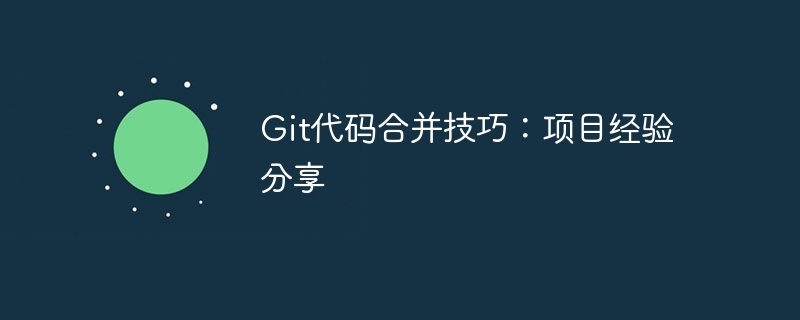

Git code merging skills: project experience sharing
In the software development process, code merging is a very important link. Especially in multi-person collaborative development projects, branches created by different developers need to be merged to ensure the integrity and consistency of the code. This article will share some Git code merging tips and experiences to help developers merge code more efficiently.
1. Keep branches clean and synchronized
Before merging code, you must first ensure that your branches are clean and synchronized. Clean means that the branch should not contain any uncommitted code modifications, while synchronized means that the branch should be developed based on the latest master branch.
In order to keep the branch clean and synchronized, we can take the following steps:
git add . to add all modified files to the staging area, and then use git commit -m "commit message" to submit all modified files to the local warehouse. git checkout main to switch to the main branch, and then use git pull to pull the latest code modifications. git merge main to merge the latest main branch code into your own development branch. If there are conflicts that need to be resolved, you can use the merge tool provided by Git or manually modify the conflicting code. 2. Choose the appropriate merge strategy
Git provides different merge strategies for handling conflicts when merging code. Commonly used merge strategies include the following:
git merge command to merge the code of other branches into the current branch. . This merge strategy preserves the history of the original commits and is relatively simple. git rebase command to rebase the commit of the current branch to the latest commit of the target branch. The commit history after rebasing is cleaner, but it will also change the order of commits. git merge -s recursive to perform a three-way merge. This merge strategy can handle conflicts in multiple branches at the same time, but it needs to ensure code consistency. Select the appropriate merge strategy based on specific project needs and development scenarios. In projects developed through multi-person collaboration, merge commit or rebase strategies are usually used.
3. Resolve code conflicts
During the process of code merging, code conflicts may occur. Code conflict means that the same part of code is modified by multiple branches at the same time, and Git cannot determine which branch's code to use. When code conflicts occur, we need to resolve the conflicts manually.
You can take the following steps to resolve code conflicts:
git status command to view conflicting files git status to view the list of conflicting files. and <code>>>> ;>>>>Mark conflicting code blocks. Based on the actual situation, choose to retain the required code blocks, delete conflict markers, and fix bugs that may be introduced due to conflicts.
git add command to mark the conflict resolved git add command to mark the conflicting file as resolved. git commit -m "resolve conflict"command to submit the code after the conflict is resolved. 4. Use Pull Request for code review
Before merging the code, it is a very good practice to use Pull Request (Pull Reqeust) for code review. Through Pull Request, other developers can review the code, discover potential problems and bugs, and give suggestions for improvement.
You can take the following steps to use Pull Request for code review:
git push origin branch_name command to push the local branch to the remote warehouse. The above are some tips and experience sharing on Git code merging. By keeping branches clean and synchronized, choosing appropriate merge strategies, resolving code conflicts, and using Pull Requests for code reviews, developers can merge code more efficiently and ensure the code quality and stability of the project. I hope these experiences will be helpful to everyone.
The above is the detailed content of Git code merging skills: project experience sharing. For more information, please follow other related articles on the PHP Chinese website!
 Solution to Connection reset
Solution to Connection reset
 Which version of linux system is easy to use?
Which version of linux system is easy to use?
 Why the computer keeps restarting automatically
Why the computer keeps restarting automatically
 Can Douyin short videos be restored after being deleted?
Can Douyin short videos be restored after being deleted?
 what is world wide web
what is world wide web
 How to solve the computer prompt of insufficient memory
How to solve the computer prompt of insufficient memory
 What does the metaverse concept mean?
What does the metaverse concept mean?
 Usage of instr function in oracle
Usage of instr function in oracle




